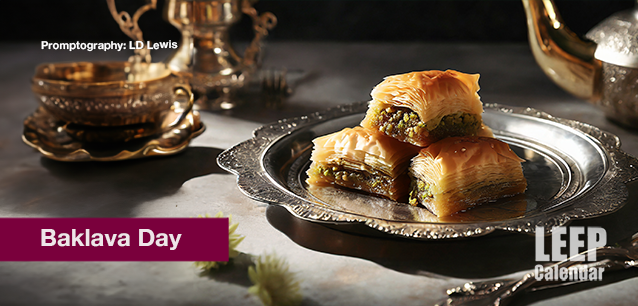 AD
AD
Today is: August 12
Scroll to explore events active on this date.
LEEP INK FEATURES

August? Absolutely!
In August, we live through the Dog Days of Summer. It's hot and often humid, and those who can leave for better climates do. Down south, winter is in full force. August is also known as "the ...

In The Heat of July: July 2025 Events
Is it hot enough (or cold enough if you're below the equator) for you yet? There is actually a day for that! Like every month, I pick a diverse collection of events you may or may not know about. This ...

May Blooms: Events in May 2025
Along with October, May is one of the most densely packed months of the year. It's before the summer humidity and the last whole month of the school year. The weather is warming in t...
About Baklava Day
United States
Ends: Nov 17, 2025
DESCRIPTION:
Baklava Day celebrates the rich, nutty pastry of Eurasia.
Baklava, a rich, sweet pastry beloved in many cultures, has a history that spans several centuries and crosses numerous borders. This layered dessert, made of filo pastry, nuts, and syrup or honey, is commonly associated with the cuisines of the Middle East, the Mediterranean, and the Balkans, with each region offering its unique twist.
The origins of baklava are unknown, with multiple cultures claiming its invention. However, baklava's roots trace to ancient times. Some food historians believe that a version of baklava was present in ancient Mesopotamia, where Assyrians layered thin pieces of dough with nuts and honey and baked them in primitive wood-burning ovens.
The dish most closely resembles modern baklava that likely emerged in the Topkapi Palace kitchens during the Ottoman Empire. During this time, chefs perfected the art of layering dough to make the palace's thin sheets of filo pastry. The Ottoman Turks then spread the recipe across their empire, including the Balkans and the Middle East.
Each region adapted baklava to its taste and traditions, leading to various recipes. In Greece, baklava is made with walnuts and cinnamon and soaked in honey syrup. In contrast, the Turkish version often includes pistachios or walnuts and is lighter on the syrup. Lebanese and Syrian baklava might feature a mix of nuts like pistachios, walnuts, and almonds and sometimes include orange blossom or rosewater in the syrup.
Baklava's journey from the Ottoman Empire to today highlights its ability to transcend cultural boundaries. The dessert is a staple at many festive occasions and celebrations across the Middle East, the Mediterranean, and the Balkans. It is often prepared in large pans and cut into various shapes, such as diamonds, squares, or rolls.
In the modern era, baklava continues to be a symbol of shared culinary history in these regions despite the variations in its preparation. Its popularity has also spread globally, with variations of the pastry found in cafes and bakeries worldwide.
VIDEOS
SUPPORTING DOCUMENTS
Currently, this event does not have supporting documents.
ADDITIONAL IMAGES
Currently, this event does not have supporting images.
Where would you like to go now?
 AD
AD


/footer-logo.svg)
